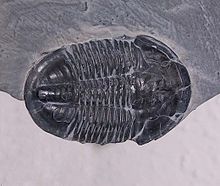Wheeler Shale
| Wheeler Shale | |
|---|---|
| Stratigraphic range: Middle Cambrian (c.507 Ma) | |
 Elrathia kingii, famed trilobite of the Wheeler Shale. | |
| Type | Geological formation |
| Thickness | 100-200 metres |
| Lithology | |
| Primary | Calcareous Shale |
| Other | Mudstone, Shaley Limestone & Limestone |
| Location | |
| Region | House Range & Drum Range, Millard Co., west Utah |
| Country | USA |
| Type section | |
| Named for | House Amphitheater (Geographic feature & type locality) |
| Named by | Charles Doolittle Walcott |
The Wheeler Shale (named by Charles Walcott) is a Cambrian (c.507 Ma) fossil locality world famous[1] for prolific agnostid and Elrathia kingii trilobite remains (even though many areas are barren of fossils) and represents a Konzentrat-Lagerstätten. Varied soft bodied organisms are locally preserved, a fauna (e.g. Naraoia, Wiwaxia & Hallucigenia) and preservation style (carbonaceous film) normally associated with the more famous Burgess Shale.[2] As such, the Wheeler Shale also represents a Konservat-Lagerstätten.[3] More detailed work recognises a number of ~10 m thick lagerstatten sequences in the formation, each of which formed at a sea-level high stand[4] in deep water.[5] The lagerstatte were deposited by turbitides and mudslides onto an oxygenated sea floor.[4]
Together with the Marjum Formation and lower Weeks Formation, the Wheeler Shale forms 490 to 610m (1,600 to 2,000ft) of limestone and shale exposed in one of the thickest, most fossiliferous and best exposed sequences of Middle Cambrian rocks in North America.[6]
At the type locality of Wheeler Amphitheater, House Range, Millard County, west Utah the Wheeler Shale consists of a heterogeneous succession of highly calcareous shale, shaley limestone, mudstone and thin, flaggy limestone.[7] The Wheeler Formation (although the Marjum & Weeks Formations are missing) extends into the Drum mountain Range, N.W. of the House range where similar fossils and preservation are found.[7]
Fauna
Recorded organisms include brachiopods, primitive echinoderms, sponges, chancellorids, carpoids, eocrinoids, trilobitomorphs, varied arthropods (e.g. anomalocarids, Emeraldella, phyllocarids), trilobites, annelid & priapulid worms, jelly fish & algae.[8][7][9][10][11][12][13] Intriguingly, the preservation of hard bodied trilobite remains and soft bodied animals seems to be mutually exclusive within particular horizons.[14][3]

References
- ^ Johnson, Kirk; Troll, Ray (2007), Cruising the fossil freeway: An epoch tale of a scientist and an artist on the ultimate 5,000-Mile paleo road trip, Golden, CO.: Fulcrum Publishing, ISBN 978-1-55591-451-6
- ^
Robert R. Gaines (2008). "Cambrian Burgess Shale–type deposits share a common mode of fossilization". Geology. 36: 755–758. doi:10.1130/G24961A.1.
{{cite journal}}: Unknown parameter|coauthors=ignored (|author=suggested) (help) - ^ a b Gaines, R (2005). "A New Hypothesis for Organic Preservation of Burgess Shale Taxa in the Middle Cambrian Wheeler Formation, House Range, Utah". Palaeogeography Palaeoclimatology Palaeoecology. 220: 193–205. doi:10.1016/j.palaeo.2004.07.034.
- ^ a b Attention: This template ({{cite doi}}) is deprecated. To cite the publication identified by doi:10.1016/j.palaeo.2009.02.010, please use {{cite journal}} (if it was published in a bona fide academic journal, otherwise {{cite report}} with
|doi=10.1016/j.palaeo.2009.02.010instead. - ^ Attention: This template ({{cite doi}}) is deprecated. To cite the publication identified by doi:10.1016/j.palaeo.2009.02.011, please use {{cite journal}} (if it was published in a bona fide academic journal, otherwise {{cite report}} with
|doi=10.1016/j.palaeo.2009.02.011instead. - ^ Robison, R.A. (1964), "Late Middle Cambrian faunas from western Utah", Journal of Paleontology, 38: 510–566
- ^ a b c Gunther, L.F.; Gunther, V.G. (1981), "Some Middle Cambrian Fossils of Utah", Brigham Young University Geology Studies, 28: 1–81
- ^ Briggs, D.E.G.; Robison, R.A. (1984), Exceptionally preserved nontrilobite arthropods and Anomalocaris from the Middle Cambrian of Utah, The Paleontological Institute, The University of Kansas
{{citation}}: CS1 maint: multiple names: authors list (link) - ^ Photos of Wheeler Shale fossils from UC Berkeley
- ^ Rigby, J.K. (1978), "Porifera of the Middle Cambrian Wheeler Shale, from the Wheeler Amphitheater, House Range, in western Utah.", Journal of Paleontology, 52: 1325–1345
{{citation}}: Text "no. 6" ignored (help) - ^ Utah's Cambrian Life from University of Kansas Natural History Museum
- ^ Cambrian fossils from Utah by the University of Utah
- ^ Comprehensive treatment from The Virtual Fossil Museum
- ^ Gaines, Robert R.; Droser, Mary L.; Kennedy, Martin J. (2001), "Taphonomy of soft-bodied preservation and ptychopariid Lagerstätte in the Wheeler Shale (Middle Cambrian), House Range, USA; controls and implications.", PaleoBios, 21 (Suppl.2): 1–55

